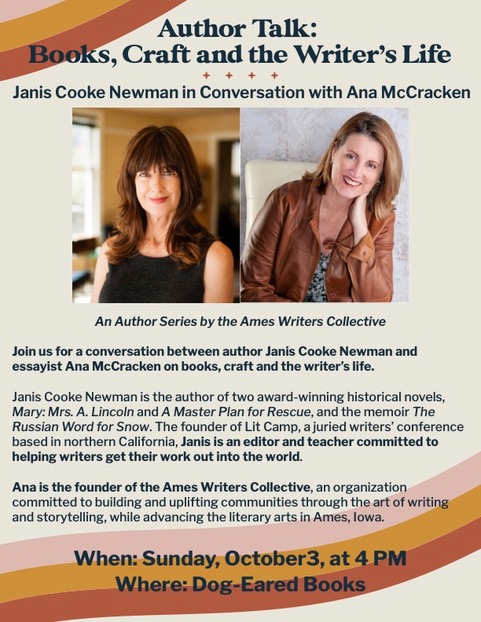Gut the Book!
My Iowa State History of the Great Plains professor, Julie, shared that tidbit when I whined about keeping up with reading in another graduate seminar class.
“Do you really think historians read every word in a book or in research papers? Learn to skim. Gut the book.” A perfectionist, the thought had never occurred to me.
I didn’t gut books Julie assigned. Her passion for the Great Plains is contagious. The spines of my favorites are shown below: Prairie a Natural History by Candace Savage, A Great Plains Reader by P. Jane Hafen and Diane Dufva Quantic, Railroad Empire Across the Heartland by James E. Sherow and John R. Charlton, and Waiting on the Bounty The Dust Bowl Diaries of Mary Dyck by Pamela Riney-Kinberg.
I also snuck into the photograph the Creative Writing Pedagogies for the Twenty-first Century by Alexandria Peary and Tom C. Hunley. This book is chuck full of fabulous workshop and literary center ideas, and helped inform the micro-memoir class I designed and taught this past spring.
And perched at the top is John Steinbeck’s The Grapes of Wrath. Professor K. L. Cook assigned The Grapes of Wrath for my cohorts’ first semester. Until fall 2018, I had managed to live life without reading The Grapes of Wrath—even though John Steinbeck is one of my favorite authors. It’s a rough read. The Dust. The caravans of people traveling to Bakersfield in search of promised work. The starvation. The flooding. The awareness nothing has really changed since the time of the books’ writing. And then I alighted upon a brilliant idea gleaned from listening to audiobooks. The Grapes accompanied me on a road trip to-and-from Ames, Iowa, to Angel Fire, New Mexico. The paperback sat beside me in the passenger seat as some actor read the book, and when something struck me other than the desperation and unending trials and tribulations, I quickly highlighted the passage. Yes, while driving. And when I wanted to “gut the book,” I hit fast forward. Even though I found the book a painful read, it’s worth revisiting. History repeats itself.
This leads me to audio books I’ve enjoyed on road trips and running errands. I highly recommend these:
Nonfiction
Tell Me More by Kelly Corrigan
Tell Me More, read by Kelly Corrigan, is touching, funny and brought tears to my eyes. It’s a book grappling with the “daily phrases” of life. Kelly has a knack for words. Her “warm, easy storytelling style” earned her praise as “America’s poet laureate of the ordinary” (HuffPost). Corrigan is often hilarious, and self deprecating. Yet she thinks and feels deeply. Hence her meditations on words such as, “I’m wrong,” “I’m sorry,” and “I don’t know.” In Tell Me More, Corrigan is contemplating what words to say in the right moment. My pages are dog-eared, as this book traveled with me on the passenger seat as I listened to Kelly read.
The Library Book by Susan Orleans
 I met Susan Orleans at the Des Moines Festival of Books in 2019. She’s engaging. During her interview she spoke about writing this book, and said something I mention whenever I can fit it into a conversation about writing.
I met Susan Orleans at the Des Moines Festival of Books in 2019. She’s engaging. During her interview she spoke about writing this book, and said something I mention whenever I can fit it into a conversation about writing.
“The why is infinitely more interesting than the what.”
Think about it this way. No one cares about a protagonist’s list of: and then I did this, and this, and this. A reader wants to dig into motivation. As in, why did the main suspect light the Los Angeles Public Library on fire? Or did he? In The Library Book, Susan attempts to uncover the why, while sharing the history of the Los Angeles Public Library system. I enjoyed listening as Susan read her book.
Mystery | Crime
Louise Penny | The Entire Inspector Gamache Series
Oh, my God! I’m on the 10th Inspector Gamache book. There’s only five more. What’s not to love about these books? While you can pick up any book in the series and read it as a stand-alone, I highly recommend starting at the beginning. (The Long Way Home is book #10) Story lines always return to the fictitious village of Three Pines where there’s a new and used book store, a bistro and bakery, and a B&B with fluffy-down bedding. Lives intertwine, and the characters are real, vivid and complicated, causing me to care deeply about them. They’ve become people I’d love to befriend. In the Inspector Gamache Series, Louise Penny expertly weaves together crime, heinous bad guys, friendship and betrayal, and history of places—Toronto, Montreal, and Quebec City—enticing you to set off in search of Three Pines. When you get there, be sure to order a warm croissant and a cafe au lait.







Can’t wait to bite into a buttery croissant, sip a cafe au lait and meet Inspector Gamache! Thanks for the recommendation.
Kris, you are welcome. I can’t wait to travel to parts of Canada that have inspired scenes in the book. Thank you for reading the post.
Hi Ana,
What a pleasure! Finding a few moments to catch up on personal correspondence tonight and loved checking out your site.
I genuinely appreciate your comment regarding the need for the self-imposed deadline; however, work at the office and non-writing projects around the house constantly get in the way.
Also, as a fellow “slow-reader,” sharing “but the book” was useful; particularly found your approach to Steinbeck via audiobook with paper copy to mark as another handy idea.
Keep going on your MFA – truly awesome!
Thank you, Joe for reading the post. I am glad to know there are other “slow readers” out there.